#the danish royal opera
Text
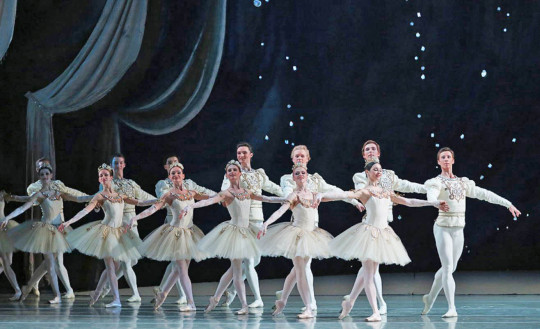
Above: the Maryinsky Ballet in the Diamonds section of Jewels. Photo: Kassir St. Petersburg
The New York Times has several new articles on the New York City Ballet to mark its 75th Anniversary Season, which opens Sept. 19. I'll be posting them all.
CITY BALLET AT 75
The Long Life and Long Reach of George Balanchine’s Butterflies
Balanchine didn’t think his ballets would last. But many have become classics, the cornerstone of repertory not just at City Ballet but around the world.
By Brian Seibert
While celebrating its 75th anniversary this fall, New York City Ballet is performing 18 ballets by its founding choreographer, George Balanchine. But to get a sense of the global standing of Balanchine, 40 years after his death, other numbers might be more telling. Last year, for instance, around 50 other ballet companies across the world performed his works, about 75 dances in total.
Balanchine likened his ballets to butterflies: “They live for a season.” But they have lasted much longer than that. They have become classics, cornerstones of the international repertory, 20th-century equivalents of 19th-century staples like “Swan Lake,” danced everywhere by all the major ballet companies and most of the minor ones, too.
These ballets, like Balanchine, emerged from the same Russian Imperial tradition as “Swan Lake,” but were shaped—as he was—by America, and by modernism and other 20th-century searches for the new. Always intimately connected to music, they sometimes told stories and sometimes, like music, were more abstract arrangements of forms and energies. They stretched ballet—in technique, in how daring and dynamic it could be, in how little outside of itself it needed — and were unparalleled in range and influence, so much so that the state of ballet is often framed as a question: Where is the next Balanchine?
City Ballet still performs by far the most Balanchine—the most ballets, the most often—but performances by other companies probably reach as many or more people, certainly in more places. All these performances, though, are connected to New York City Ballet, because the dissemination of his works remains a matter of lineage—of connections to Balanchine.

Above: Ballet Imperial (Tchaikovsky Piano Concerto #2) performed by the Paris Opera Ballet, with Valentine Colasante and Pablo Legasa. Photo: Agathe Poupeney
Before City Ballet became a durable laboratory and library for Balanchine’s choreography, he often worked as a choreographer for hire. That’s why American Ballet Theater dances “Theme and Variations,” which he made for that troupe in 1947. But few of the companies he created works for have survived, and most of the works that survived are those that became part of the City Ballet repertory. The company was the hub from which his influence radiated.
In the early years of the company, Balanchine sometimes staged works for European troupes with which he was connected: Paris Opera Ballet, the Royal Danish Ballet, what became the Royal Ballet. The reception to his innovations, especially the more radical ones, was highly variable, both abroad and in the more ballet-bereft country he had made his home. There, Balanchine was both generous and prudent with his ballets.
“He was giving them away for free, but he was in control,” said Jennifer Homans, the author of “Mr. B: George Balanchine’s 20th Century.” “Looking at the correspondence, you can see he was careful about who could do it and who couldn’t, and about which ballets could be done by others and which couldn’t.” He staged them himself, or he sent people he trusted. Francia Russell danced with City Ballet from 1956 to 1961. Since 1964, when she became a ballet master at the company, she has staged more than 200 productions of Balanchine ballets for other troupes. “They weren’t many people doing it at the beginning,” she said. “At first, I staged only ballets that I had actually danced.” Later, it became possible to consult films, but Russell didn’t use them much. “I always said I’m staging them the way I danced them when with Mr. B was with us.”
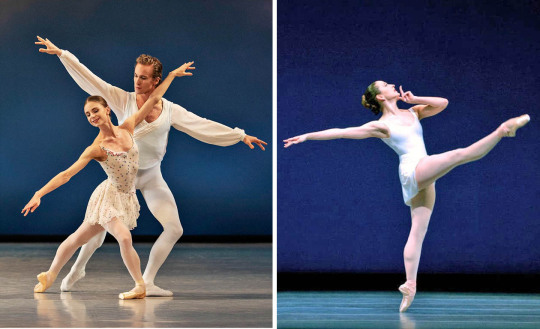
Left: Ida Praetorius and Jón Axel Fransson of the Royal Danish Ballet in Ballo della Regina. Photo: Henrik Stenberg
Right: Pacific Northwest Balllet's Carrie Imler in Apollo. Photo: Angela Sterling
It was during the 1960s that City Ballet became a dominant institution, with a custom-built theater in the new Lincoln Center. An exceptionally large grant from the Ford Foundation put City Ballet and its affiliated School of American Ballet at the helm of a program to support ballet and ballet education. Following Balanchine’s recommendations, the foundation granted seed funding to regional troupes like Boston Ballet and Pennsylvania (now Philadelphia) Ballet. Balanchine granted these fledgling companies something nearly as important: some of his works, free of charge.
That process continued as members of City Ballet founded their own companies or became artistic directors. Arthur Mitchell, the company’s first Black principal dancer, erected the repertory of Dance Theater of Harlem, founded in 1969, on a foundation of Balanchine pieces. Some City Ballet dancers found leadership roles in Europe, like Patricia Neary in Switzerland. In 1977, Russell and her husband, Kent Stowell, moved from Frankfurt Ballet to Pacific Northwest Ballet in Seattle and built it into another outpost of Balanchine repertory.
“Mr. B said he trusted me to only ask for the ballets I thought our dancers could do,” Russell said. “And whatever we wanted, it was ‘Of course, dear.’ He never asked for a penny.” These ballets, she added, “were an education in classical dance for our dancers,” a sentiment commonly voiced by artistic directors. After Balanchine’s death, in 1983, the City Ballet diaspora spread further. In 1985, Edward Villella, a City Ballet star of the 1960s and ’70s, transformed Miami City Ballet into a Balanchinian troupe. That same year, Helgi Tomasson, after dancing with City Ballet for 15 years, became artistic director of San Francisco Ballet, a post he held until 2022. None of these and other companies led by City Ballet alumni danced Balanchine exclusively, but there was a family connection. Successors were often in the family, too. Russell and Stowell were followed (in 2005) by Peter Boal, Villella (in 2012) by Lourdes Lopez, both former principals at City Ballet and alumni of its school.

Above: the San Francisco Ballet in Divertimento #15. Photo: Dave Morgan
By this point, acquiring a Balanchine work was no longer “Of course, dear.” Skeptical that his works could last without him, and never much interested in posterity, he left his ballets in his will not to City Ballet but to 14 dancers and colleagues. The George Balanchine Trust was formed in 1987 to bring some order and stability to the licensing and restaging. The stagers it authorized were all dancers who had been with Balanchine in the classroom and rehearsal studio.
Now Balanchine works circulated to places where they had not before been part of the repertory. Russell was the first to stage one in China, in 1987. The next year, she brought one to the Soviet Union — to the institution then known as the Kirov Ballet (now the Mariinsky), where Balanchine had trained in the first decades of the 20th century but where few of the dancers had seen his works or knew much about him.
Always, there have been questions about authenticity. Balanchine frequently changed his choreography—for different dancers and stages—so which was the right version and in whose memory of it? And beyond the steps, was the spirit transferable, the elusive and usually unspoken ideas, the all-important musicality? Disagreements about these questions—applied to companies of dancers not trained in Balanchine’s aesthetic and modifications to technique, but also to City Ballet—were perpetual and often heated. For many viewers, Balanchine after Balanchine wasn’t Balanchine at all, and couldn’t be. Balanchine had suggested as much himself. And now a new phase is coming. As Russell put it, speaking of her generation, “We’re all too old to preserve that tradition in the same way.”

Above: Left: Sandra Jennings of the Balanchine Trust rehearsing Gabriella McCann of the City Ballet of San Diego. Photo: K.C. Alfred
Right: Symphony in C, second movement, with Olga Smirnova and Dennis Rodkin of the Bolshoi Ballet. Photo: Damir Yusupov
Lopez, who is 20 years younger, made a similar point. “There aren’t many of us,” she said, “who worked with him and still talk about him as if he were next door.” But she also spoke about dancers, at Miami City Ballet and elsewhere, hungry to learn Balanchine’s aesthetic, dancers born after he died who talk about him as if they knew him.
It is those kinds of people who make Suki Schorer feel positive about Balanchine’s legacy. A City Ballet member from 1959 to 1972, she wrote a book on Balanchine technique and has been teaching at the School of American Ballet for some 60 years. Asked about Balanchine’s influence today, she listed young teachers, trained at the school, who have fanned out across the country.
Silas Farley is one. Born 11 years after Balanchine died, he encountered the Balanchine lineage at the school of North Carolina Dance Theater, which was run by the former City Ballet stars Patricia McBride and Jean-Pierre Bonnefoux. Farley became obsessed with Balanchine lore, which he absorbed deeply at the School of American Ballet and as a City Ballet member from 2013 to 2020.
“I have always had an acute sense that I’m one of the people who has been entrusted with a lot of these ideas and that, God willing, I’ll be here a long time after the people who entrusted those ideas to me,” he said on a call from Southern Methodist University, where he teaches.
His students, he said, are “empowered by all of Balanchine’s cool amendments and extensions of classical technique. They delight in the granular and the grand, the nuances and the capacity to dance more expansively, more freely.” Balanchine’s works, he added, “are such a big part of their understanding of what ballet is.”
Their understanding and everyone else’s. Those works, however altered by time, remain ubiquitous. Nikolaj Hübbe, a Danish dancer who performed with City Ballet from 1992 to 2008 and has led the Royal Danish Ballet ever since, is one of those who believe in their enduring power. “I don’t think I’ve ever worked with a dancer, even if Balanchine was foreign to them, who did not have an epiphany, a wow feeling, dancing his ballets,” Hübbe said. “Our dancers love them, revel in them. There’s a logic that speaks to all classically trained dancers. The choreography sings well. I don’t think that will ever go away.”
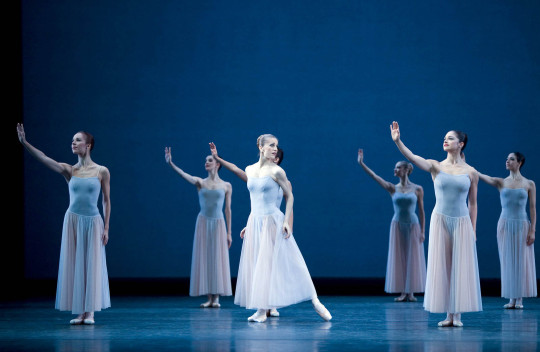
Above: Marianela Núñez and the Royal Ballet in Serenade, 2008. Photo: Johan Persson
#Balanchine#ballet#Balanchine ballet#Balanchine's legacy#rehearsing Balanchine#Maryinsky Ballet#Paris Opera Ballet#Royal Danish Ballet#Pacific Northwest Ballet#San Francisco Ballet#City Ballet of San Diego#NYCB@75#Bolshoi Ballet#Royal Ballet#Brian Siebert#Francia Russell#Lourdes Lopez#Silas Farley#Nikolaj Hubbe
25 notes
·
View notes
Text
Royal Danish Ballet 1902 - Pas De Deux
Clara Rasmussen and Margrethe Andersen - Pas de Deux. Royal Danish Ballet. ELFELT FILM 1902. Filmed in studio with Denmark's first film camera by Peter Elfelt.
Happy International Dance Day.
#classical music#opera#music history#Royal Danish Ballet#composer#classical composer#classical studies#Pas De Deux#International Dance Day#Dance#ballet#old footage#footage#ballerina
6 notes
·
View notes
Text
Full Length Ballet Performances
Cinderella
Instituto Nacional De Las Bellas Artes 🩰 Russian National Ballet
Coppelia
Paris Opera Ballet 🩰 Bolshoi Ballet Theatre
Don Quixote
The National Ballet Theatre of Ukraine 🩰Teatro alla Scala di Milano Marrinsky Theatre
Giselle
Bolshoi Ballet Theatre 🩰 Polish National Ballet 🩰 The Royal Danish Ballet 🩰 National Opera and Ballet Theatre of Mari El
La Bayadère
National Opera and Ballet Theatre of Mari El.🩰 Bolshoi Ballet Theatre
La Fille Mal Gardée
Serbian National Ballet
La Sylphide
The Royal Danish Ballet
Marguerite & Armand
The Royal Ballet
Mayerling
Stainslavsky Ballet
Nutcracker
The New York City Ballet 🩰Marrinsky Theatre 🩰 National Opera and Ballet Theatre of Marie.El
Romeo and Juliet
Ural Opera Ballet🩰 Bolshoi Ballet Theatre
Swan Lake
Kirkov Ballet 🩰 St Petersburg Ballet Theatre 🩰 American Ballet Theatre 🩰 Bolshoi Ballet Theatre
The Sleeping Beauty
Staatsballett Berlin 🩰 National Opera and Ballet Theatre of Mari El 🩰 Marrinsky Theatre 🩰 l'Opéra Bastille 🩰Teatro alla Scala 🩰 Bolshoi Ballet Act 1 Bolshoi Ballet Act 2
The Rite of Spring (Le sacre du printemps)
Marrinsky Theatre
I was born in the correct generation because I loved those photos so much, I decided to look up the ballet so I could watch it and there it was ! I have added other full length performances as well and for most of the pieces I have added different ballet companies (if I could find) just because different ballet companies means different choreography ( not always but certain companies are reowned for their distinct style)
Enjoy!
xo Daphne
4K notes
·
View notes
Text
99 years, 11 months, 27 days
The Palais Mermonia
“Good moooooooooooooooorning ladies!”
Furina was usually in a chipper mood when she swanned out of her suite, but as her mistress left her Palais apartments, Eponine could have sworn she was beaming… and only partially because of the glowing blue jewel around her throat.
Is that the jewel? Fantine mouthed behind Furina’s back, eyes widening as Eponine nodded furiously. It had been smaller when Eponine last laid eyes on it, but there was no mistaking the distinct shimmer and hue of the gem she had seen in Neuvillette’s hands. The one she had been asked to keep a secret from Furina.
“Good morning, ma’am,” Sana said, blinking owlishly at the jewel as Furina’s guards trailed after her. “You’re in high spirits today.”
“Well why shouldn’t I be?” Furina laughed. “It’s a holiday, my dear demoiselles; everyone is entitled to an extra slice of joy!”
“I’m glad to see you more optimistic than you were yesterday, ma’am,” Sana chuckled. “Something must’ve lifted your spirits.”
Or some one , Eponine thought, sharing a knowing look with her friend. Perhaps it was just the promotion to the Royal Guard that put her in closer contact with the Archon’s household, but Eponine could have sworn the Iudex and the Archon were becoming less and less secretive about their affections for one another. She had seen nothing concrete of course, but Eponine had seen Neuvillette carry a sleeping Archon to her chambers enough times to question whose bed she would be sleeping in.
“Unfortunately, my birthday party can’t be all fun and games,” Furina sighed, snatching a danish from a melusine pushing a cart topped with food. “Has the Liyue delegation arrived yet?”
“The Honorable Madam Cloud Retainer is awaiting Your Eminence in the western drawing room,” Sana said.
“So early? My my, someone is eager to make my acquaintance, aren’t they?” Furina laughed, covering a thoughtful frown with a bite of food. It’s barely nine; did they take a speedboat from Liyue?
“If I were invited to an Archon’s birthday party, I would be eager as well,” Sana said. “She has not been waiting long; her party arrived at Romaritime Harbor a few hours ago and made straight for the Court.”
“No other adepti are with her?” Furina asked.
“No recognizable figures were with Madam Cloud Retainer when she presented herself to the Palais staff,” Fantine reported. “She arrived with twenty or so bureaucrats and representatives of Liyuen merchant families; they’re currently settling into the Liffey Wing of the Palais as per your instructions.”
“Good, good…w-were any of these dignitaries tall, golden-eyed young men with long brown hair?” Furina asked. “...by any chance?”
“Not that I could see,” Eponine said. “Someone we should be concerned about, ma’am?”
“No no, just a…doctor of the adepti that aided M. Neuvillette some years ago,” Furina said, waving her hand dismissively. A doctor and the foremost god killer in Teyvat.
Rex Lapis’ absence brought Furina no comfort; the last time the adepti visited Fontaine, they had come unexpectedly armed and had roughed her Iudex up. Granted, even Neuvillette admitted that he started it, but Furina still didn't like random demigods traipsing into her city unnoticed. Only one adeptus had been recorded entering the city, but all that told her was that there could be more that weren’t recorded. The Court of Fontaine was jammed to the gills with tourists and visitors from all over the world; if anyone wanted to enter the city undetected, today would have been the perfect day.
“Has M. Neuvillette been informed of this?” Furina asked.
“He is informed, but he’s dealing with the delegation from Inazuma at the moment,” Sana said. “They passed through Romaritime Harbor shortly after the delegation from Liyue; M. Neuvillette asked that they be received at the Opera before they were brought to the Palais.”
I wonder if he wants to meet that Minamoto no Makoto character…or perhaps he just wants an opportunity to size up Miss Miko before she sinks her teeth into me, Furina thought. Little was known about Inazuma’s high priestess other than that she was crafty, well connected, and (distressingly) beautiful. Furina had no real rival for Neuvillette’s affections; the women who flirted with him all failed to pierce his somewhat stuffy facade like Furina had...but none of them had been beautiful spirits either. Miko had more power in her fingernail clippings than Furina had in her entire body and everyone knew dragons lusted for power.
Oh stop it; you have too much on your plate to worry about boy troubles , Furina chided herself, shaking her head. Or rather man troubles...or rather dragon man troubles...
Read More...
Chapter 1
37 notes
·
View notes
Text
The beautiful thing about the Bear is that it's such a high stress show that you can apply it to other high stress environments and the AU works. I can see some kind of hospital/medical AU, or, in this case, a dancer AU.
The Berzattos run a dance school for kids, teens, and adults. They do different styles of dance, teach according to syllabus and some of their best students, like Carmen Berzatto even go on to become professionals. Syd used to go there when she was a kid until her dad noticed her passion, and worked extra hard to get into the Joffrey Ballet, then the New York Ballet before she got disillusioned and tried to start her own dance company and failed.
Carmy joined the Joffrey Ballet in Chicago, being taught by Andrea, as a child before being picked up by the Paris Opera ballet, before moving to the Royal Danish Ballet in Copenhagen, then moving onto the San Francisco Ballet before finally joining the American Ballet Theatre in New York, this is where David abuses him.
Mikey didn't have as much promise, he was a good dancer at many things, but didn't have the drive that Carmy did, so runs the dance school instead. He met Richie at the school, his mother was a dancer and she noticed his inability to sit still and put him in the dance school, his dad didn't approve at first but he started getting roles in musicals, he's a brilliant tap dancer and could've gone far in musical theatre but Mikey pulled him in. He got roles, worked hard for them but always got brought back to the dance school eventually.
Tina got into musical theatre 'too late', she's been in a local theatre outside of work but after getting fired, she's heard singing to herself at the bus stop outside the dance school, Mikey hears and offers her a job as the musical theatre teacher with Richie.
Mikey dies and Carmy's left the dance school. The place isn't doing well, they could be going out of business. Syd, who's been idolising him since she saw him in the Royal Danish's production of the Nutcracker, starts to work there. Carmy becomes strict on uniform and respect to the teacher, Richie's more relaxed, he's dance teacher but wants it to be fun, not a military school.
She and Richie don't get on, she's used to the skill levels of professional ballet studios, not local dance schools. She starts to see how good he is with the students, he can control the room easier and his students have more freedom and are generally happier.
Carmy decides to up the stakes of the school's usual yearly show, they promise Jimmy a certain amount of profit and a certain number of new uptake of students. They ask Tina choreograph her own section of the show to whatever she wants, she goes with West Side Story.
Sydney looks at some of the previous shows, and some of the previous work of the teachers to see if there's anything they could possibly do and stumbles upon some of Richie's work in musical theatre. She mentions it to Carmy, they talk to Richie, who's unsure as it's been a while.
She's there late one night when she hears something and sees Richie dancing to Singin in the Rain, which he performed on tour. They talk about dreams and goals, she encourages him to perform, but he's hesitant as it's been so long
Syd and Carmy are going to do a duet, but when it comes to the night, Carmy gets locked in one of the dressing rooms getting something for one of the kids. Syd's scared, so Richie improvises and steps in, he's seen them rehearsing and does his best (is this all because I want to imagine Richie lifting Syd like she weighs nothing? yes).
She joins him in doing 'Moses Supposes' from Singin in the Rain (minus the singing), something he used to perform with Mikey, because she makes him feel confident enough to perform again. They get through, make a fair bit of money and get some sign ups. Richie also gets an invitation to audition for another musical, with Syd's encouragement, he does.
Also added on: Eva being in Richie's dance class, Richie and Syd are in suits when they dance together to 'Moses Supposes', Syd and Richie teaching a class together and reluctantly getting along
#the bear#this caters to me and only me#i used to dance#in a dance school that did a bit of everything#and i love tap#there's not enough tap musicals anymore#can you tell i love singin in the rain?#richie jerimovich#sydrichie#sydney adamu#syd adamu#mikey berzatto#michael berzatto#carmy berzatto#carmen berzatto#tina marrero#if you want to know why richie's a tap dancer#it's because he's loud and complex#like tap#whereas carmy seems like a ballet guy#also jeremy allen white was a dancer
24 notes
·
View notes
Text

"Plumage flowing in elegant symmetry, the celebrated Royal Danish Ballet performs Tchaikovsky's Swan Lake. Ballet, opera, drama, and the Royal Orchestra thrive under the financial umbrella of the state-owned Royal Theater in Copenhagen.
National Geographic - February, 1974
50 notes
·
View notes
Text
✨ 15 days of Princess Anne ✨
August is Princess Anne’s birth month and her 73rd birthday is on the 15th so until then we will look at her fascinating life, one photo for every year!
The sixties
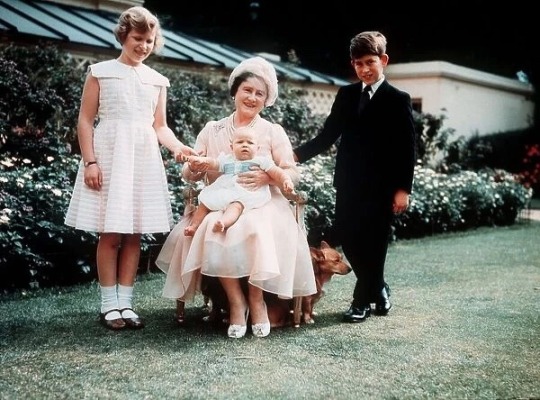
1960 Queen Elizabeth, The Queen Mother with her three grandchildren, Princess Anne, Prince Charles and newborn Prince Andrew, August 1960.
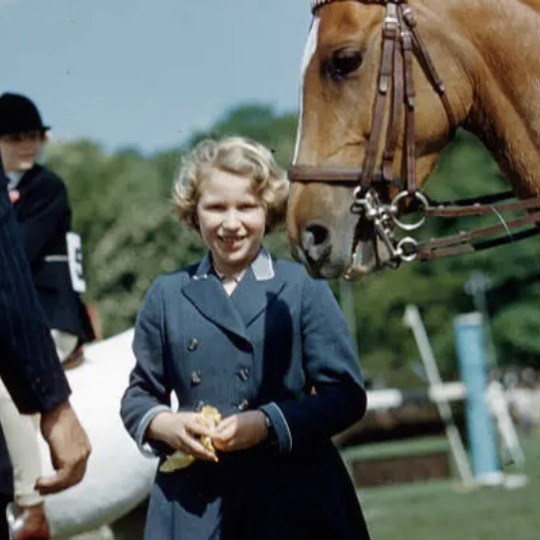
1961 Princess Anne at the Royal Windsor Horse Show in Berkshire on 13th May 1961.
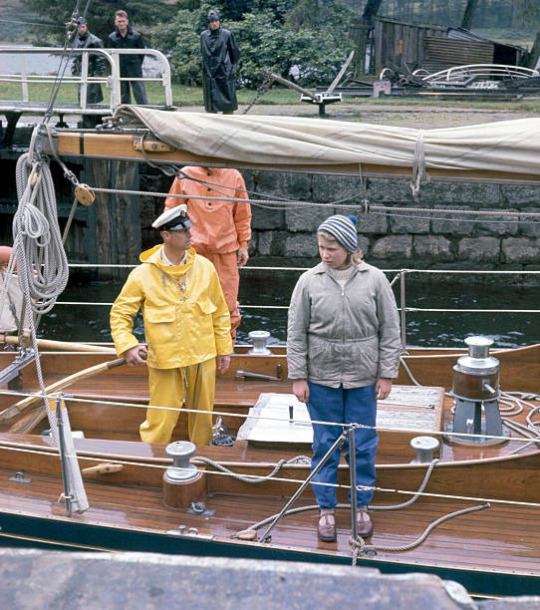
1962 Prince Philip at the helm (in yellow sou'wester) with his daughter Princess Anne on board the Royal Yawl "Bloodhound" during a sailing holiday on Loch Oich, Invernesshire on 23rd August 1962.
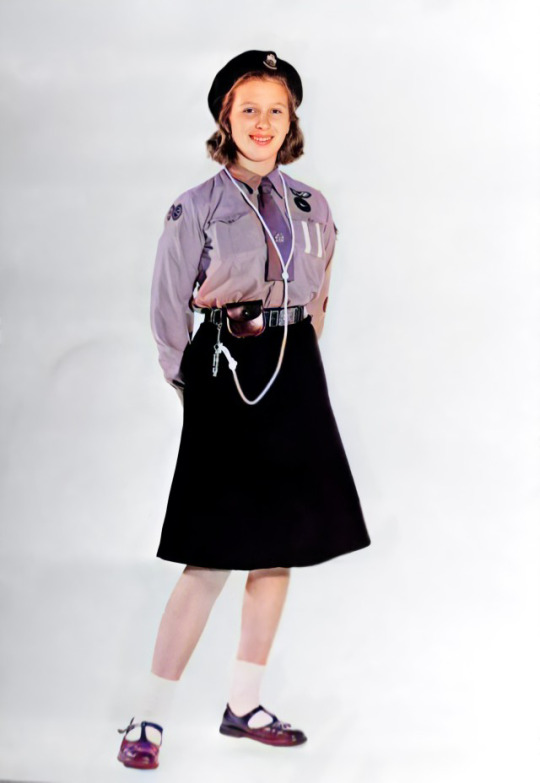
1963 A portrait of Princess Anne wearing a girl guides uniform taken for her 13th birthday on 9th August 1963
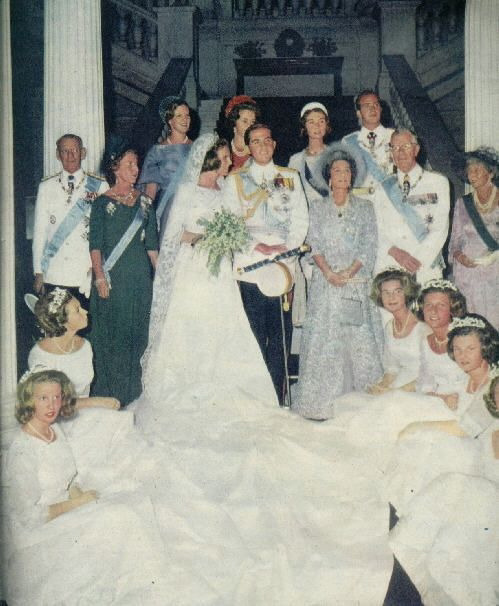
1964 Princess Anne (bottom left) as a bridesmaid at King Constantine & Queen Anne-Marie’s wedding on 18th September 1964.
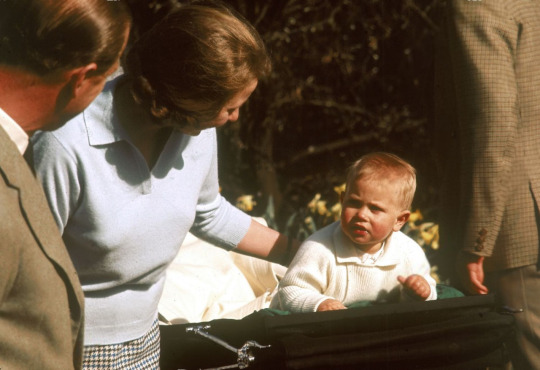
1965 One year old Prince Edward in his pram with his elder sister Princess Anne and their father Prince Philip which was taken at Frogmore on 13th April 1965.

1966 Princess Anne with Prince Charles and Prince Philip, behind the wheel arriving at a polo match in Kingston, Jamaica on 10th August 1966.
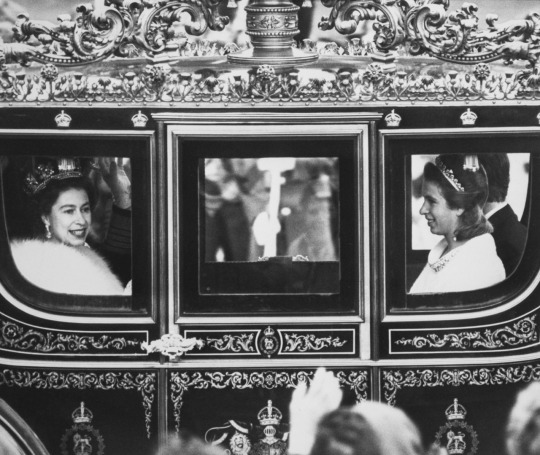
1967 Princess Anne’s first tiara appearance (the Cartier Halo tiara), at the 1967 state opening. She is travelling in a state coach with her mother, Queen Elizabeth II, her father, The Duke of Edinburgh and her brother, Prince Charles to the Houses of Parliament.

1968 Princess Anne (front, second from left) with members of the Danish and British royal families in the royal box at the Royal Opera House in Covent Garden, London, UK, 29th April 1968. From left to right, Prince George of Denmark, Princess Margaret, Queen Ingrid of Denmark, Queen Elizabeth II, King Frederick IX, Queen Elizabeth The Queen Mother and Princess Anne of Denmark.

1969 Princess Anne at her first ever engagement where she launched Esso Northumbria in Newcastle on 02/05/1969
(50’s)
66 notes
·
View notes
Text
Hetalia Human Names
NOTE: This is my personal interpretation and the names may diverge from canon and established fanon. Also I might update this every so often to make it more accurate, depending on the information I find.
Table of Contents
The Main Characters
Western Europe
Northern Europe
Eastern Europe
Southern Europe
Western Asia
South Asia
East Asia
Southeast Asia
Oceania
Micronations
Former nations
The Main Characters
Italy Veneziano: Feliciano Vergano
I chose the name Vergano instead as it keeps the essense of the original surname, but is actually Italian.
Italy Romano: Lovino Vergano
Germany: Ludwig Beilschmidt
Japan: Kiku Honda
Prussia: Gilbert Beilschmidt
America: Alfred Franklin Jones
I like the headcanon of his middle name being "Freedom", but Franklin is my personal favourite.
England: Arthur James Kirkland
I came across this in a fic a while back and never looked back. This man needs a middle name.
France: Francis Bonnefoy
Russia: Ivan Braginsky
China: Yao Wang
Canada: Matthew Williams
Western Europe
Austria: Roderich Edelstein
Belgium: Laura Janssens
Liechtenstein: Erika Vogel
Luxembourg: Henri Janssens
I've also used the name Gabriel before, but it doesn't seem to be used much in Luxembourg, so Henri would be more fitting.
Monaco: Louise Bonnefoy
The name Louise and it's masculine variant, Louis, appear a few times in the Monaguesque royal family.
Netherlands: Willem Janssens
Willem appears a few times in the Dutch royal family, and it sounds a bit older than other suggested names, which reflects his age and general vibes imo. I really like this name.
Switzerland: Sebastian Zwingli
Personally I see his name "Basch" as a nickname for Sebastian. It's also easy to adapt to his official languages: Sebastian/Sébastién/Sebastiano. The Romansh variant would be Bistgaun, but the archaic version seems to be Bastgaun, which is more similar to Basch. I headcanon that he goes by the name "Basch" in all languages to make it more cohesive.
Northern Europe
Denmark: Mathias Rasmussen
I'm from Scandinavia myself and I don't know if it's widespread, but I've heard people say "all Danish people are named Rasmus" more than once, so I like to incorporate that into his surname.
Estonia: Eduard Kaasik
Around 50% of Estonia is covered in forest, and one of the most common tree types is birch. Kaasik is a common surname and means "birch forest".
Finland: Timo Väinämöinen
Iceland: Eiríkur Steinsson
Steinsson means "son of Stein (given name meaning stone)",. Also Emil isn't traditionally Icelandic, but it's widely used. Personally though, I prefer the name Eiríkur.
Latvia: Raivis Bērziņš
The surname Galante corresponds with the modern Latvian opera singer Inese Galante, but I couldn't find anything to suggest it's commonly used or that it's Latvian at all. Bērziņš is one of the most used Latvian surnames and means "birch tree", like Estonia's surname. Personally, I don't see the Baltics as siblings, but I think this would be a cute reference.
Also, based on what I read, surnames became common in Latvia around the 19th century, with Bērziņš being one of them. Latvia could have picked up whatever the people around him (Estonia) was using and made it his own.
Lithuania: Tolys Laurinaitis
Norway: Sigurd Bondevik
Sweden: Berwald Oxenstierna
Eastern Europe
Belarus: Natalya Arlovskaya
Bulgaria: Mihail Petrov Isporov
Isporov is the family name and is derived from an alternative name of Asparukh, the first king of the First Bulgarian Empire.
Czech: Tereza Novakova
Hungary: Erzsébet Héderváry
Moldova: Marcel Popescu
Poland: Feliks Łukasiewicz
Romania: Vladislav Popescu
Slovakia: Jozef Novak
Ukraine: Iryna Chernenko
Southern Europe
Greece: Herakles Karpusi
Portugal: João Silva Ferreira
Spain: Antonio Fernandez Carriedo
Western Asia
Cyprus: Stasinos Karpusi
Stasinos was one of the first European poets who wrote the epic poem Cypria.
Turkey: Sadiq Adnan
TRNC: Tarkan Adnan
South Asia
India: Rajesh Thakur
East Asia
Hong Kong: Leon Wang / Wong Kulung
Macau: Chen Wang
South Korea: Im Yong-soo
Taiwan: Mei Lin
Southeast Asia
Thailand: Prasert Chakri
Vietnam: Lien Nguyen
Africa
Cameroon: Emmanuel Mawdo Ahidjo
Many of the most commonly used forenames in Cameroon are of French or English origins, such as Emmanuel.
Mawdo means ‘elder’ in Fulfulde.
Ahidjo refers to the first president of Cameroon.
Egypt: Gupta Muhammad Hassan
Seychelles: Michelle Mancham
Americas
Cuba: Carlos Machado Rodríguez
Oceania
Australia: Daniel Kirkland
New Zealand: Zachary Kirkland
Micronations
Hutt River: Christopher Kirkland
Kugelmugel: Leopold Edelstein
Ladonia: Erland Oxenstierna
Molossia: Jacob Jones
"JJ" :)
Sealand: Peter Kirkland
Seborga: Romeo Vergano
Okay listen. I have no explaination, I just really like this name. Also, if the names of the trio is Peter, Wendy, and Romeo, they're all named after characters from literature. I think that's fun.
Wy: Wendy Kirkland
Former Nations
Ancient Egypt: Neferure
References the only biological child of Hatshepsut.
Ancient Greece: Helene
Ancient Rome: Marcus Valerius Maximus
Marcus is the praenomina (given name) and refers to how Romulus and Remus were said to have been twins of Mars, the god.
Valerius is the nomen gentilicium (hereditary name) and means “to be strong”.
Maximus is the cognomen and means “the greatest”.
Germania: Alaric
Holy Roman Empire: Otto Beilschmidt
Personally I like the idea that HRE and Germany aren't the same person, but share the same body.
58 notes
·
View notes
Text

You can:
use either or both prompts as given
use either or both lists for prompts
use the name of either or both lists as a prompts
complete as many or few days as you want
write, draw, craft, or anything else!
There's no deadline and this is just for fun. I'll reblog this with links to the lists if you want to explore.
What's RainbowFic? We're a community of original fic writers on Dreamwidth using prompt lists named after colors (for a very VERY loose definition of color). Our lists range include song lyrics, quotes from books and tv, themed words, contrasts, and a whole lot more (we have over 400!)
Text version of the list under a readmore
Text version:
Day 1: Royal Purple #11 Further beyond / Iceberg #12 Snowman
Day 2: Lilac #25 Freesia / Opera Mauve #20 Curtain call
Day 3: Lavender's Blue #2 Mermaid / Periwinkle #14 Enamel heart pendant from a garage sale
Day 4: Caramel #8 Gummies / Vert #16 As the lord/lady asks
Day 5: Midnight #6 Furtive / Psychedelic Purple #15 I know I'll never be the same
Day 6: Lotus #19 Truthfulness / Ignition Yellow #10 There are some nights I wait for someone to save us
Day 7: Green Go #21 Rideshare / Gold #12 The only way not to think about money is to have a great deal of it
Day 8: City Street #4 Highway / Greenstick Fracture #9 I got the velocity and now all I need is the mass
Day 9: Paprika #8 We've got something kinda funny going on / Harvard Crimson #14 Library
Day 10: Danish Red #2 The Snow Queen / Amaranth #5 Stars
Day 11: Pull Me Over Red #1 Parking ticket / Daffodil #5 Flowers
Day 12: Fluorescent Pink #19 It doesn't matter who they are, I won't forgive anyone who tries to stand out more than me / Parrot Green #13 Call
Day 13: Crane White #18 Tell your daughters do not walk the streets alone tonight / Spirits of Saturn #15 Overgrowth
Day 14: Cherry #12 Grapes / Skylight #4 Smoking on the fire escape
Day 15: Calcite #4 Soft/Hard / Burgundy #2 Varietal
Day 16: Yellow Submarine #17 The long and winding road that leads to your door will never disappear / White Opal #2 Dream
Day 17: Tigers Eye #8 Eerie empty spaces / Moonlight #1 Liminal
Day 18: Baby Blue #4 Sling / Red Dress #5 You need to find a new solution, adaptation or retribution
Day 19: Gunmetal #14 Crossbow / English Violet #3 Since I cannot prove a lover, to entertain these fair well-spoken days, I am determined to prove a villain
Day 20: Heirloom Silver #2 Heirloom / Brown #5 Brown bagging
Day 21: Coomassie Blue #1 Repressor / Folly #14 Relax, I saw it on TV
Day 22: Fuzzy Wuzzy #3 Hugs /Alien Green #6 This is where you pucker up and kiss my ass
Day 23: Fawn #4 Cat / Grand Ink #20 With a mug of hot tea and some Vicodin in my bloodstream, I look up from my book to watch the bugs outside the windows
Day 24: Royal Blue #2 Queen / Spirit Purple #19 Screw the binary gender system
27 notes
·
View notes
Text



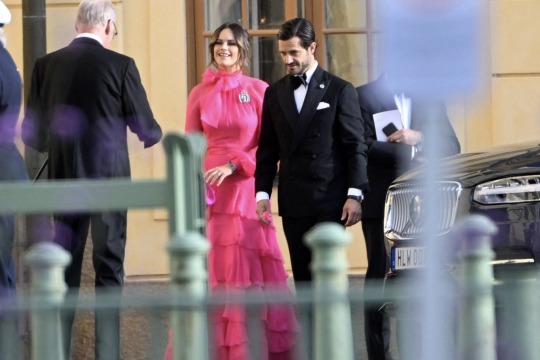


Swedish and Danish Royals arrive at Drottningholm Palace Theatre in Stockholm for the Royal Opera's jubilee theatre performance, in connection with the 50th anniversary of King Carl XVI Gustaf's accession to the throne | September 14th, 2023
#swerf#drf#queen silvia#queen margrethe#crown princess victoria#prince daniel#princess estelle#prince oscar#princess christina#prince carl philip#princess sofia#crown princess mary#crown prince frederik#princess madeleine#chris o’neill#king carl gustaf
30 notes
·
View notes
Text
I believe the first ballet to A Midsummer Night’s Dream was Marius Petipa’s version for the Maryinsky Ballet in St. Petersburg in 1876. It was this that Michel Fokine in 1906 adapted and amended for students of the Imperial School. The cast included Vaslav Nijinsky, and it proved one of the very early works of Fokine to capture the attention of the impresario Serge Diaghilev. Fokine later reworked the score into Les Elfes for his own company at the Metropolitan Opera House in 1924. In 1933 Col. W. de Basil’s Ballets Russes de Monte Carlo staged David Lichine’s first ballet, Nocturne, using not Mendelssohn but Rameau music, with Alexandra Danilova as Titania, Léonide Massine as Oberon, and Lichine himself as Puck.
But the four most interesting versions for me are George Balanchine’s for New York City Ballet in 1962, Frederick Ashton’s for Britain’s Royal Ballet in 1964, John Neumeier’s for the Hamburg Ballet in 1977, and Christopher Wheeldon’s for the Colorado Ballet in 2000. All, except for the Ashton, are full-evening ballets. Wheeldon’s version not unexpectedly owes something to both Ashton and Balanchine. Neumeier’s version—which is by far the most adventurous and original and incorporates modern music by György Ligeti—has also been staged by the Paris Opera Ballet and the Royal Danish Ballet.
#shakespeare#william shakespeare#dance#ballet#shakespeare and dance#balanchine#midsummer#a midsummer night's dream
9 notes
·
View notes
Note
The trailer for Ehrengard is out! Daisy designed the costumes, and they look great, but I feel weird about her working for Netflix in a way I didn't when she was designing for the Danish Royal Opera company. What do you think?
Hey :) I was very confused when I read this first sentence. Thought this was going to be another one of those random asks about something I've literally never expressed interest in haha. But anyway. It'll sound like a cop out but I don't really have a strong opinion because it's so culturally specific. Royals are essentially public representatives whose job is to represent the societal norms of their country and so there's this huge part of responding to royalty which requires an implicit understanding of a culture's values and behaviours and history. I can talk about the British royals because they're my royal family, I'm entitled to, but I also have an understanding of what is and isn't culturally acceptable even if it's not something written down. As a British person I get really irritated when people pipe up about and say stupid things about our royal family when they aren't from here. So I try not to do it for others lol. That doesn't mean I don't ever talk about other royals or criticise them, of course. But it means that I generally try to criticise when I feel like I have something to say that isn't culturally specific. So for example:
If they're breaking the law - a good example is Carl Gustaf's "flexible" interpretation of the Constitution when it came to his grandchildren. Not many people in Sweden actually care, understandably, but I felt justified in having a view because Swedish people created their constitution and CG's job is to stick to the constitution. So I'm judging them for not upholding something Swedish people asked them to uphold
Something that's always morally bad - I'm thinking MT's bullying accusations. No matter what culture you're from, it shouldn't be acceptable to be such a terrible boss that people are literally terrified to go to work. Even if Luxembourg had just shrugged at that one I think anyone is entitled to call that out as it's essentially a human rights issue.
Where I have it on reliable authority from someone in the country that they feel a certain way - So for example in Norway, I know that Martha Louise's business activities have been controversial because I know Norwegian people and I read the Norwegian press.
Something like Margrethe working with Netflix is difficult because it's not objectively morally bad, I don't know of any Danish ethics guidelines it would be breaking, and I don't know if Danish people are bothered by it. So I have no real hook to guide my opinion, if that makes sense. I can see exactly why it would be preferable to have stayed with places like the Opera - something that's a Danish cultural institution and for the benefit of the people - and I know that if it was in the UK I'd be asking questions about what they were paid, why they're doing this instead of royal duties etc but it's not the UK and I can't just copy and paste my response to a different culture. Does that make sense? I guess basically it does immediately not sit well with me because of my own cultural context but I can't actually make a judgement call because I don't know what is and isn't ok in Denmark and that's where she's Queen.
16 notes
·
View notes
Text
Peter Cornelius - In fernem Land (Lohengrin) - 1907
The Danish heroic tenor Peter Cornelius (1865-1934) was one of the leading tenors at the Royal Danish Theatre from the mid-1890's to around 1920.
He made his debut as a baritone in 1893, and four years later he re-appeared as the heroic tenor in all the major roles in Wagner's operas.
Peter Cornelius (whose real name was Cornelius Petersen) not only performed in Copenhagen, but he was also a regular guest at Covent Garden from 1907 to 1914.
Cornelius retired in 1924.
#classical music#opera#music history#bel canto#composer#classical composer#aria#classical studies#maestro#chest voice#Peter Cornelius#tenor#baritone#heldentenor#Royal Danish Theatre#Covent Garden#Royal Opera House#Lohengrin#Richard Wagner#classical musician#classical musicians#classical history#historian of music#musicians#musician#opera singer#Danish opera singer
2 notes
·
View notes
Text

If anybody deserved the title of “Renaissance man” it would be Carl Davis, who has died aged 86 following a brain haemorrhage. A formidably gifted composer and conductor, in a career spanning seven decades he wrote scores for a string of successful films and a long list of some of the best remembered programmes on British television, including the 1995 BBC production of Pride and Prejudice.
Davis won a Bafta and an Ivor Novello award for his score for Karel Reisz’s The French Lieutenant’s Woman (1981), scripted by Harold Pinter and starring the Oscar-nominated Meryl Streep, and worked on many other prominent films, including Scandal (1989), starring Ian McKellen and Joanne Whalley, Ken Russell’s The Rainbow (1989) and The Great Gatsby (2000). His theme music for the 1984 horse-racing drama Champions, starring John Hurt as the Grand National winner Bob Champion, was subsequently used by the BBC for its Grand National coverage.
A fascination for the era of silent movies prompted Davis to create new scores to accompany numerous classics from cinema’s early years, including his composition for Abel Gance’s sprawling 1927 epic, Napoleon. His work helped trigger an international revival of presentations of silent films with a live orchestra.
He achieved another career highlight when he collaborated with Sir Paul McCartney on his Liverpool Oratorio, an eight-movement piece based on McCartney’s experiences of growing up in Liverpool. The piece was recorded in Liverpool Cathedral in 1991, featuring the classical soloists Kiri Te Kanawa and Willard White.
Despite his relentless schedule and prolific output, Davis enjoyed a reputation as an expansive and witty conversationalist who could always make time for friends or interviewers. When conducting at occasions such as the Royal Liverpool Philharmonic’s Summer Pops concerts or the BBC’s Proms in the Park, he would gently subvert notions of classical seriousness by conducting in a union jack outfit or a gold lamé coat.
Born in Brooklyn, New York, Carl was the son of Sara (nee Perlmutter), a teacher, and Isadore Davis, a post office worker. His Jewish family had ancestry in Poland and Russia. Encouraged by his mother, he displayed precocious musical ability. He started playing piano at the age of two, and soon became an adept sight-reader. He recalled how from an early age he would listen to the Metropolitan Opera’s live radio broadcasts on Saturday afternoons, and he would obsessively study musical scores of operas and orchestral pieces obtained from Brooklyn’s public libraries.
He took lessons with the composers Hugo Kauder and Paul Nordoff (later the co-founder of the Nordoff-Robbins music therapy programme), then with the Danish modernist composer Per Nørgård in Copenhagen. He studied at Queens College, New York, and the New England Conservatory of Music, Boston, and as an 18-year-old served as an accompanist to the Robert Shaw Chorale. He then attended Bard College in Annandale-on-Hudson in upstate New York, which has had a remarkable roll-call of actors, writers, film-makers and musicians pass through its portals. He graduated from Bard as a composer, having already begun to compose music for theatrical productions.
In 1958 he became an assistant conductor at the New York City Opera, and then won an off-Broadway Emmy award as co-composer of the 1959 revue Diversions. This was staged at the Edinburgh festival in 1961 and subsequently transferred to the Arts theatre in London, retitled Twists. It caught the eye of Ned Sherrin, then working in production at the BBC. He commissioned Davis, who had moved to London and was living in decrepit lodgings in Notting Hill, to write music for the satirical TV show That Was the Week That Was.
It was the start of his prolific and varied career in the UK. The Davis touch added lustre to the television movies The Snow Goose (BBC, 1971) and The Naked Civil Servant (Thames Television, 1975); the adaptation of the Anita Brookner novel Hotel Du Lac (BBC, 1986); and the miniseries A Year in Provence (BBC, 1993) and A Dance to the Music of Time (Channel 4, 1997) among many others.
A notable milestone was his ominous and unsettling score for Thames’s The World at War (1973), which was produced by Jeremy Isaacs. It was through Isaacs that Davis became involved in the Thames TV series Hollywood: A Celebration of the American Silent Film, based on the book The Parade’s Gone By … by the film historian Kevin Brownlow.
Davis was tasked with tracking down musicians who had worked on films during the silent era, and the series set him off on a decades-long crusade to revive silent films with newly created scores. He enjoyed the challenge of conducting the music live as the film played. “You have to keep going,” he told the Arts Desk’s Graham Rickson in 2021. “Some conductors use click tracks and headphones. I’m old-fashioned and don’t like being tied to machinery – I try to conduct these things with as little apparatus as possible.”
The most dramatic expression of this was his work on Napoleon, and in 1980 Davis conducted a performance of it with an orchestra and audience at the Empire, Leicester Square. “That first screening wasn’t flawless, but it was electrifying,” he recalled. He subsequently conducted performances around the world, and the score let to him being appointed chevalier of France’s Ordre des Arts et des Lettres in 1983.
He went on to compose music for more than 50 silent films featuring stars such as Greta Garbo and Rudolph Valentino, for comedies by Charlie Chaplin, Harold Lloyd and Buster Keaton, and for classics such as Ben-Hur (1925), the Douglas Fairbanks swashbuckler The Thief of Bagdad (1924) and DW Griffith’s Intolerance (1916).
Another genre which Davis excelled at composing for was dance. “The relationship between film and ballet is striking, and I find myself composing more and more ballet scores now, something which the film work has made me much better at,” he told Rickson. For Northern Ballet theatre, he worked with the choreographer Gillian Lynne on A Simple Man (1987) and Lipizzaner (1989). For Scottish Ballet, he collaborated with Robert Cohan, a fellow New Yorker, on A Christmas Carol (1992) and Aladdin (2000). And for English National Ballet’s Alice in Wonderland (1995), Davis (commissioned by ENB’s artistic director Derek Deane) drew on themes by Tchaikovsky.
It was also through Deane’s influence that Davis was commissioned by the National Ballet of Croatia to write Lady of the Camellias (2008), which gave him the opportunity to revisit Alexandre Dumas’s original novel and Verdi’s operatic version of it, La Traviata. The opera had been a favourite of Davis’s since his childhood days of listening to Met broadcasts, and he had also worked on a production of it for New York City Opera. The resulting piece gave the story a contemporary twist, so “the action could flow without pause and indeed the production did effectively utilise projections and film”, as Davis wrote in the recording’s sleeve notes.
He received a Bafta special lifetime achievement award in 2003, and in 2005 he was made CBE.
In 1970 he married the actor Jean Boht, who starred in Carla Lane’s sitcom Bread. She survives him, along with their daughters, Hannah and Jessie.
🔔 Carl Davis, composer and conductor, born 28 October 1936; died 3 August 2023
Daily inspiration. Discover more photos at Just for Books…?
16 notes
·
View notes
Note
Oh what ballets have you gone too and would you recommend them? The ones I do want to go to havent been put up locally yet so im thinking of widening my horizons until im in a better position to travel.
OKAY Omg I'm so happy to spout off about this!!!!!!!
My absolute favorites are ballets by the choreographer Balanchine, who founded the New York City Ballet. To start I would recommend Serenade (Tchaikovsky music to die for), Concerto Barocco (Bach), Symphony in C (Bizet), Jewels and Chaconne as entries. He has GREAT leotard ballets set to modern classical music but you have to like dissonant or atonal music (like Hindemith) and have patience for no costumes no sets no story and only movement which is not friendly if you don't already know his style. He also made a wonderful Nutcracker and a Midsummer Nights Dream if you want a story ballet. The New York City Ballet owns that repertory but! The Paris Opera Ballet has for years been doing a FABULOUS job of it too as have Stuttgart Ballet.
I have been to 4 types of ballets (my own categorization) put up by the following companies - New York City Ballet and other Balanchine type ballet companies, the American Ballet Theater, the Marijnsky, the Bolshoi, the Royal Ballet, the English National Ballet, the Royal Danish Ballet, the Paris Opera Ballet, the Korean National Ballet, Universal Ballet, San Francisco Ballet and the Bulgarian Varna Ballet too.
The four types of ballets are
1. Story ballets. 2. No story ballets 3. Modern ballets (sometimes story sometimes costume sometimes neither) 4. Total reworkings/Broadway adjacents
The Story ballets are Nutcracker, Giselle, Swan Lake, La Bayadere, Romeo and Juliet - that most companies will cycle through and put on. Oh Cinderella and Sleeping Beauty too - I like the English National and the Royal Ballet versions of these a lot.
The English, French, Danes and Russians all have very distinct styles from each other in terms of how they like to do movement and narrative using very similar steps and the same music so I would start anywhere and just dig in. I wish I could say stuff about the Italians like the Scala but I have only seen individual dancers like the IMMENSELY AMAZING Roberto Bolle and Alessandra Ferri doing guest spots with the ABT so I can't say.
The no story ballets are mostly Balanchine to me bc I see them as separate from the work of Jerome Robbins who sometimes had little plots and sometimes didn't.
These I would call Modern Ballets. Jerome Robbins is another WONDERFUL choreographer who is known for West Side Story which is sad bc I don't like those dances and his modern ballets are so much better! Like Afternoon of a Faun (two dancers meet in an empty rehearsal room and have a whole compact romance), Dances at a Gathering, Goldberg Variations. Fancy Free puts three Ballet boys in sailor outfits doing the cutest moves ever. He also made The Cage where female insects kill their males after mating. I recommend all of these but for Goldberg - the pianist can have a hard time lol.
Roland Petit made a Carmen for Paris Opera Ballet which is super sexy, which I also recommend.
Once you've seen a couple Swan Lakes - I would go with Bolshoi and Paris Opera just for comparison - and you like more Broadway type dancing you might want to watch Matthew Bourne's Swan Lake with boy swans. Completely reworked but so good.
I want to know more about Danish Ballet because of Bournonville- there's this wonderful friendly energy, a relaxed elegance to Danish Ballet that is very unique to that country but I haven't had that much chance.
Shading over into straight up modern dance, Twyla Tharpe made In the Upper Room which I saw danced by the American Ballet Theater which I found so cathartic I went into a crying jag of hysteria in the elevator down to the parking lot of Lincoln Center. Jerome Robbins also made a Ballet set to music by the same composer, Phillip Glass, Glass Pieces, which is so fun and feels very loving to New York City.
Uhh I think I have to stop even though I can say more. Anyway Ballet is great and I think everyone should go. Even bad Ballet performed badly is always worth it to me
#ballet#george balanchine#Jerome robbins#i meannn if you want more current choreographers like people who are alive NOW i also have recs for those#just lemme know lol
3 notes
·
View notes
Text
RUDOLF NUREYEV
RUDOLF NUREYEV
1938-1993
Russian ballet dancer
Rudolf Nureyev was born into a poor peasant family in Russia (Soviet Union) and wanted to become a dancer since seeing the opera as a child. He started studying ballet at age 11 and as he got older he joined the top ballet company in Russia, the Kirov Ballet.
In 1961, he fled Communist-controlled Russia and deflected at the Le Bourget Airport in Paris.
He went on to dance with the Royal Ballet in London and formed a famous partnership with dancer Margot Fonteyn and became one of the best-known dancers in the world.
He socialized with well-known celebrities including Freddie Mercury, Liza Minnelli, Andy Warhol, Jackie Kennedy Onassis and allegedly had an affair with Mick Jagger (Mick Jagger also had a threesome with David Bowie and Bette Midler). Nureyev later grew tired of socializing with celebrities but remained friends with those in the ballet world.
Nureyev was bisexual and would often pick up young men. In 1961, he met Danish dancer Erik Bruhn and they became a couple. In 1973, he had an affair with American dancer Robert Tracy.
Nureyev was notorious for having one-night stands. When AIDS became known in 1982, Nureyev took little notice. One of his previous lovers who had contracted HIV rang up Nureyev and advised him to get tested which he did in 1984 and tested positive but kept it a secret whilst his health declined. In November 1992 he entered the hospital in France and died there aged 54 in January 1993.

#rudolfnureyev
3 notes
·
View notes